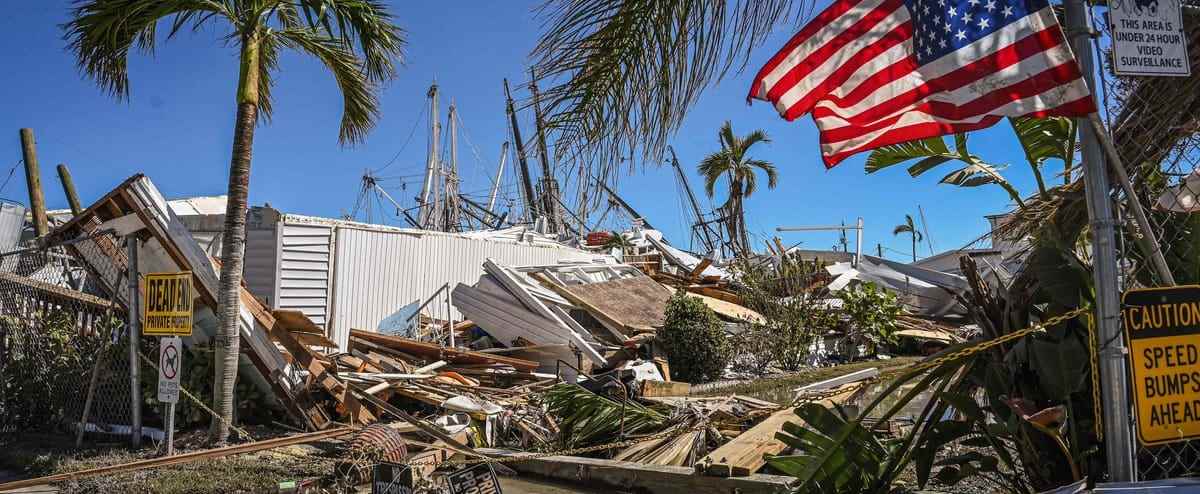Florida continued on Saturday to see the heavy toll, already amounting to several dozen deaths, from the passage of Hurricane Ian, which should dissipate during the next night after causing floods in South Carolina.
• Read also: Storm Ian, now in South Carolina, has killed at least 23 in Florida
• Read also: Hurricane Ian: Human remains rise to the surface in a Florida cemetery
Florida authorities on Saturday brought the provisional toll to 25 victims, most of them drowning and the vast majority of them elderly.
Hurricane-hit Lee County alone has recorded 35 deaths, according to its sheriff, while US media, including NBC and CBS, have recorded more than 70 deaths directly or indirectly related to the storm.
The controversy swelled on Saturday around the late arrival of the evacuation order for more than 600,000 inhabitants of this county, which accounts for half of the confirmed victims.
The order would have been given Tuesday morning, while neighboring counties asked their residents to evacuate on Monday, says the New York Times.
“Nobody tells us what to do”
Sitting in the shade of a deserted house in Matlacha, Chip Farrar grows exasperated. “Nobody tells us what to do. Nobody tells us where to go,” he told AFP.
“The evacuation orders came very late,” says the 43-year-old man. “But most of the people who are still there wouldn’t have left anyway. It’s a very working place. And most people have nowhere to go, that’s the biggest problem,” he adds.
At the same time, the search continued to find sixteen passengers from a migrant boat which capsized due to bad weather on Wednesday near the Keys archipelago.
The Coast Guard said it found two people from the boat dead in the water, with nine others rescued either offshore or after swimming to shore.
After ravaging Florida, Ian headed for South Carolina, where it made landfall Friday afternoon near Georgetown as a Category 1 hurricane, with winds up to 140 km/h, according to the Miami-based National Hurricane Center (NHC).
Unprecedented
On Saturday afternoon, Ian was carrying winds of up to 35 km / h with still “heavy rain” on the Appalachian Mountains in the southeastern United States, the NHC said in its latest bulletin.
Despite its expected weakening, the authorities of several states still called on the population to be cautious due to the heavy rainfall expected.
More than 500,000 homes and businesses were without power Saturday at midday in North Carolina, South Carolina and Virginia, according to the specialized site poweroutage.us.
Florida still had nearly 1.2 million homes and businesses without power.
In the peninsula, in addition to the heavy human toll, the material damage is “historic”, the level reached by the rising waters having been unprecedented, according to Governor Ron DeSantis.
Streets and homes were flooded and boats moored in marinas were tossed onto land by the storm. On Friday, in Kissimmee, not far from Orlando, the authorities crossed the flooded areas in boats to rescue residents trapped in their homes.
Years to rebuild
In this state, “we are just beginning to see the extent of the destruction”, “likely to rank among the worst” in the history of the United States, said President Joe Biden.
“It will take months, years to rebuild,” he lamented.
In the coastal town of Fort Myers, called an “epicenter” by Ron DeSantis, a handful of restaurants and bars had reopened and dozens of people were seated on terraces, offering residents a semblance of normalcy between broken trees and destroyed facades.
“It was pretty terrible, but we held on. The roof of our house blew off, a big tree collapsed on our cars, our garden was flooded, but other than that, it’s fine,” said Dylan Gamber, 23, welcoming the solidarity that reigned among neighbours.
According to initial estimates, the passage of Hurricane Ian could cost insurers tens of billions of dollars and will weigh on American growth, in particular due to flight cancellations and damage to agricultural production.
1,100 people rescued
More than 1,100 people have been rescued in the state so far, Gov. Ron DeSantis’ office said Saturday morning.
According to a first rapid study by American scientists made public on Friday, the rains linked to Hurricane Ian have increased by at least 10% due to climate change.
“Climate change didn’t cause the hurricane, but it did make it wetter,” said one of the scientists involved in the study, Michael Wehner, of the Department of Environment’s Lawrence-Berkeley National Laboratory. Energy.
Before Florida, Ian had hit Cuba, causing three deaths and extensive damage and leaving many homes without power there too.





